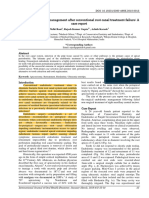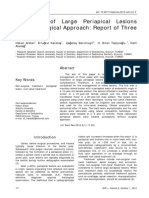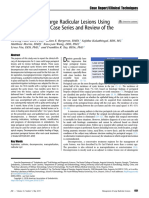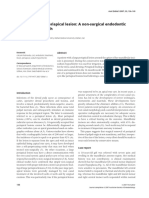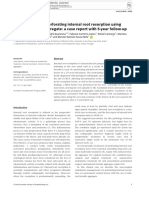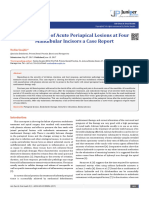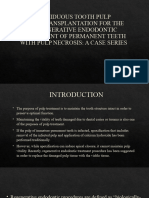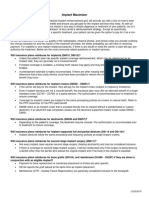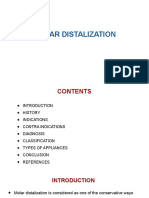Periapikal
Periapikal
Uploaded by
HanindyaNoorAgusthaCopyright:
Available Formats
Periapikal
Periapikal
Uploaded by
HanindyaNoorAgusthaOriginal Title
Copyright
Available Formats
Share this document
Did you find this document useful?
Is this content inappropriate?
Copyright:
Available Formats
Periapikal
Periapikal
Uploaded by
HanindyaNoorAgusthaCopyright:
Available Formats
CASE REPORT
Romana Persic Bukmir, Sonja Pezelj-Ribaric, Ivana Brekalo Prso, Bozidar Pavelic
A successful conservative therapy of a large
periapical lesion by surgical decompression and
ozone treatment: case report
KEY WORDS
ozone, periapical abscess, periapical periodontitis, root canal therapy, surgical decompression
ABSTRACT
Background: Odontogenic fascial space infections originate from infected root canal(s) and can
spread through the periapical area of a tooth to the surrounding bone and overlying soft tissues.
Microbial causative agents of these lesions can be present in the form of an intraradicular or
extraradicular infection and their treatment can be particularly problematic.
Case presentation: A successful outcome of a therapy to treat a chronic apical abscess with
mental space involvement and cutaneous sinus tract in a 20-year-old patient is presented in this
case report. The treatment was performed by means of surgical decompression and ozone treat-
ment. Twenty months after the end of treatment the patient was asymptomatic and the control
radiographs revealed the healing of the periapical tissues. At the 4-year recall the periapical
radiographs revealed the absence of the periapical lesion. Though the surgical intervention with
complete enucleation of a periapical lesion may be the most expeditious treatment option, it can
cause undesirable consequences.
Conclusion: This article demonstrates how a conservative approach in therapy can offer a favour-
able outcome, allowing the practitioner to choose an alternative treatment option.
Introduction Natkin et al3 have assumed that larger lesions
are more likely to be cysts and therefore are less
Microbial causative agents of post-treatment ap- likely to be resolved by root canal treatment alone.
ical periodontitis can be present as an intraradicular According to investigations based on meticulous
or extraradicular infection. Depending on the rela- serial-sectioning and strict histopathological cri-
tion of the apex of the involved tooth and the mus- teria the actual incidence of periapical cyst is below
cular attachments, the infection may extend into 20%4. More than half of these lesions are true
a fascial space. While Enterococcus faecalis is the periapical cysts and the rest of them are designated
most consistently reported microorganism found in as periapical pocket cysts. While periapical pocket
infected treated root canals, Actinomyces israelii cysts may heal after conventional root canal treat-
and Propionibacterium propionicum are consist- ment, apical true cysts are not likely to heal with-
ently isolated from periapical tissues of teeth that out surgical treatment5.
did not respond to proper nonsurgical root canal Treatment of large periapical lesions that resist
treatment1. In such cases, the success of nonsurgi- conventional therapy can be problematic. Although
cal root canal treatment is questionable due to the surgical intervention with complete enucleation
inability to eliminate bacteria beyond the apex2. may be the most expeditious treatment option, it
ENDO EPT 2019;13(3):265–271 265
Persic Bukmir et al Conservative therapy of a large periapical lesion by surgical decompression and ozone treatment
can cause undesirable consequences such as loss of largest diameter of the lesion was approximately
the vitality of the adjacent teeth, which compro- 2 cm. A clinical diagnosis of chronic apical abscess
mises their osseous support, or cause damage to with mental space involvement and an extraoral
the adjacent nerves. Therefore, the ideal therapy sinus tract was established. Informed consent was
would be to eliminate the lesion, or at least to obtained from the patient according to the pro-
reduce its size by surgical decompression. This pro- tocol of the ethical review board of the Clinical
cedure allows continuous drainage from the peri- Hospital Centre Rijeka.
apical lesion, which eliminates conditions favour- Initially, the therapy plan involved a surgical
ing the expansion of periapical pathosis resulting decompression in order to establish an alternative
in healing by osseous regeneration6. path for abscess drainage and reduce the size of the
Ozone is a powerful oxidizing pale blue gas, lesion before surgical enucleation. Also, an ozone
soluble in water and nonpolar solvents. It exists in treatment with the purpose of periapical tissue dis-
natural form in the atmosphere or it can be pro- infection was planned. To gain access to the peri-
duced by generators7. Ozone therapy has been apical area through the root canal, the root canal
used for wound-healing improvement, immune filling of tooth 31 was retreated using stainless steel
system modulation and disinfection8. In dentistry, hand files at the working length of 22.5 mm, up to
its use has been recommended for soft tissue heal- apical size 50. The canal was irrigated with 2.5%
ing during surgical procedures9, root caries treat- sodium hypochlorite solution (Dline OU,Tallinn,
ment and root canal disinfection10-13. Estonia) during instrumentation and 17% ethyl-
The purpose of this case report is to illustrate enediaminetetraacetic acid (EDTA) (Vista Dental
a conservative approach in the management of Products, Racine, WI, USA) at the end of instru-
a large periapical lesion and consequential fascial mentation. After the final rinse with sterile saline (B.
space infection by means of surgical decompres- Braun Melsungen, Melsungen, Germany), an intra-
sion and ozone treatment. canal calcium hydroxide dressing (Calxyl, OCO
Präparate, Dirmstein, Germany) was placed. One
week later a surgical decompression was made.
Case report After infiltration anaesthesia, a vertical incision was
made between the root eminences of teeth 31 and
A healthy 20-year-old woman sought treatment, 32 and a polyethylene tube was inserted into the
complaining of pain and swelling of her chin. An depth of the lesion cavity. The tissue incision was
extraoral examination revealed the presence of a sutured around the tube. One suture was placed
sinus tract stoma in the central chin area with puru- through the mucosa and through the tube to sta-
lent exudate discharge (Fig 1a). The mandibular bilise it during the initial healing (Fig 2a). A periapi-
central incisors and left lateral incisor (teeth 41, cal radiograph with a gutta-percha point (Dentsply
31 and 32) exhibited sensitivity to percussion and Maillefer, Ballaigues, Switzerland) inserted into the
palpation. Root canal treatments of these teeth lumen of the tube was made to verify its position
had been performed in our department 5 months (Fig 2b). After 10 days, healing was complete and
before by an endodontic specialist. Thermal and the sutures were removed. Extraoral sinus tract
electric pulp testing revealed a normal reac- stoma was absent. The patient was instructed
tion in the adjacent teeth. In order to determine to irrigate the cavity of the periapical lesion daily
the extent of the lesion, a cone beam computed through the lumen of the tube with 0.12% chlor-
tomography (CBCT) scan was taken. The scans hexidine according to the protocol suggested
revealed an adequate root canal obturation in all by Brøndum and Jensen14. A 2 ml syringe and a
three involved teeth; however, a large well-defined 18-gauge blunt Luer Lock dispensing tip were used
radiolucent lesion perforating the frontal cortical for irrigation. The lumen of the tube was wider than
plate of the mandible was present (Fig 1b to d). the dispensing tip, allowing the liquid to flow out
The lingual cortical plate was not damaged. The from the cavity.
266 ENDO EPT 2019;13(3):265–271
Persic Bukmir et al Conservative therapy of a large periapical lesion by surgical decompression and ozone treatment
Fig 1a to d
(a) Sinus tract stoma
in the central chin
area. (b to d) CBCT
scans showing a
large, well-defined
radiolucent lesion
with extensive
destruction of the
frontal cortical bone
of the mandible: (b)
transversal section,
(c) sagittal section,
and (d) axial sec-
tion.
a b
c d
Fig 2a and b
(a) Insertion and
stabilisation of a
decompression
tube by interrupted
sutures, (b) peri-
apical radiograph
with a gutta-percha
point inserted into
the lumen of the
tube to verify its
position.
a b
The patient was recalled every 10 days for the by PSKP syringe (Plasma One, Plasma Medical
next 6 weeks. In the next three visits the following System, Bad Ems, Germany). PSKP syringe is a
protocol was applied. The lesion cavity was lav- specially designed syringe containing a centrally
aged with sterile saline through the decompres- positioned glass tube filled with noble gas and sur-
sion aperture. Ozone was generated and applied rounded by a metal mesh. Ozone is generated
ENDO EPT 2019;13(3):265–271 267
Persic Bukmir et al Conservative therapy of a large periapical lesion by surgical decompression and ozone treatment
Fig 3a and b healed with a slight skin retraction (Fig 4c). At the
(a) Control peri-
apical radiograph 4-year recall examination there was no tenderness
after root canal on palpation or percussion. Periapical radiographs
filling and the drain
removal showing
showed an absence of the periapical lesion. The
reduction in size periapical area of teeth 31 and 32 healed with
of the periapical
radiolucency,
delicate trabecular bone of a lower density than
(b) control radio- the surrounding bone (Fig 5a and b).
graph 2 months
after treatment
showing further
reduction in size
of the periapical a b Discussion
radiolucency.
Besides intraradicular infection, the potential
from aspirated atmospheric air by dielectric barrier causes of persistent periapical radiolucency may
discharge in the space between the glass tube and be extraradicular infection, foreign body reaction,
metal mesh. During the process of instillation, the cholesterol crystals that may cause irritation of per-
glass tube slides inside the hollow plunger, push- iapical tissues, true cystic lesions and scar tissues1.
ing the ozone-enriched air mixture through the In teeth with apparently adequate root canal treat-
tip of the syringe. Two syringes per visit (approxi- ment conventional periradicular surgery with com-
mately 4.4 ml) were delivered in the lumen of the plete lesion enucleation is frequently the therapy
lesion through the root canal of tooth 31 using a of choice. Bone lesions larger than 2.5 cm, particu-
30-gauge needle. During the ozone application a larly those that perforate the cortical plate, have an
drainage of purulent foamy exudate was visible unpredictable prognosis for complete bone heal-
through the aperture of the decompression site. At ing15,16. Regenerative surgical techniques may be
every appointment the length of the drainage tube used to improve bone healing in lesions that are
had to be shortened as it was forced out by the larger than 10 mm in diameter. They include fill-
resolution of the lesion cavity. Between appoint- ing of the bone crypt with calcium phosphate or
ments the root canal of tooth 31 was treated with physiologic bone substitutes and covering the cor-
a calcium hydroxide dressing. After 6 weeks, the tical defect with membranes to prevent epithelial
tube was removed and the root canal obturation migration16,17.
of tooth 31 was performed by cold lateral compac- A decompression procedure is classified as fis-
tion technique using gutta-percha and AH-Plus tulative surgery and can be used before or instead
sealer (Dentsply DeTrey, Konstanz, Germany). The of apical surgery, minimising the potential dam-
control radiograph after the root canal filling and age to the adjacent anatomical structures18. It
the tube removal showed a reduction in the size of reduces the size of the lesion, making the surgical
the periapical radiolucency and a delicate trabecu- intervention unnecessary in many cases. The pro-
lar pattern at the periphery of the radiolucent area cedure disrupts the integrity of the lesion wall,
(Fig 3a). After the patient was informed of further eliminates internal osmotic pressure and promotes
treatment options, it was decided not to under- healing by osseous regeneration19. It was reported
take any further surgical intervention. Two months that conventional root-end surgery and surgical
later further reduction in the size of the periapical fenestration provide comparable results in terms
radiolucency was noted (Fig 3b). Twenty months of healing rate20. However, the potential short-
after the end of treatment the patient was asymp- comings of the decompression include patient
tomatic and control radiographs revealed healing compliance, frequent recalls, long-term follow-
of the periapical tissues. The small semilunar rar- up, unavailability of biopsies for histopathologi-
efaction present around the apex of teeth 31 and cal examination, incompatibility with regenerative
32 may have been the consequence of scar tissue surgical techniques and possible infection of the
formation (Fig 4a and b). The sinus tract opening exposed cavity21. The following radiographic and
268 ENDO EPT 2019;13(3):265–271
Persic Bukmir et al Conservative therapy of a large periapical lesion by surgical decompression and ozone treatment
Fig 4a to c
(a and b) Two pro-
jections of control
radiographs taken
20 months after the
end of treatment
showing the healing
of the periapi-
cal tissues, (c) the
sinus tract opening
healed with a slight
skin retraction.
a b c
clinical criteria are suggested for termination of Fig 5a and b Peri-
apical radiographs of
decompression: The radiograph should reveal a teeth (a) 42 and 41,
thin delicate trabecular pattern throughout the and (b) 31 and 32
at the 4-year recall
radiolucent area and the cavity should show clin-
appointment show-
ical evidence of a progressive reduction in size, ing the absence of
resulting in the need to reduce the cannula several the periapical lesion;
periapical area of
times. Finally, there should be no untoward signs teeth 31 and 32
or symptoms of the lesion such as purulent dis- healed with delicate
trabecular bone of a
charge, pain, etc22. lower density than
The accurate histological diagnosis of periapical the surrounding
a b bone.
lesions cannot be based on preoperative clinical or
radiological findings. A recent study determined
that CBCT images can only provide a moderately Their establishment in the periapical tissues either
accurate diagnosis of cysts and granulomas23. by adherence to the external root surface in the
Since biopsy for histopathological examination form of biofilm structures or by the formation of
cannot be obtained during decompression, the cohesive actinomycotic colonies may interfere with
diagnosis remains presumptive and depends on the resolution of periapical lesions27. The bacteri-
the treatment outcome. cidal efficacy of ozone is based on forming oxida-
The location of fascial space infection of odon- tive radicals in aqueous solutions, which damages
togenic origin is determined by the position of the the cell membranes due to altering osmotic perme-
root end in relation to its overlying buccal or lingual ability and stability28. Therefore, the rationale for
cortical plate and the relationship of the attach- ozone use in such cases is justified since its effec-
ment of a muscle. The source of the mental space tiveness against anaerobes has been well docu-
infection is the mandibular anterior teeth where mented29-32. However, there is no consensus on
the purulent exudate breaks through the buccal application manner, time and optimum dosages of
cortical plate and the apex of the tooth lies below ozone for achieving significant results.
the attachment of the mentalis muscle24. A sinus Introducing gas into closed periapical tissues is
tract of odontogenic origin may open through the not permitted as it may result in air emphysema,
skin of the face and can be mistaken for other with well-known complications. The use of gase-
cutaneous infections or malignant diseases and ous ozone requires the establishment of an outlet,
treated ineffectively25,26. The healing process of a in this case a decompression aperture, to prevent
sinus tract will occur only if the offending tooth is air emphysema. Ozone must be expressed slowly
properly treated. and gently while carefully visually controlling the
Current evidence indicates that anaerobes play foamy exudate discharge through the decompres-
a major role in infections of endodontic origin. sion aperture. Before the procedure, the integrity
ENDO EPT 2019;13(3):265–271 269
Persic Bukmir et al Conservative therapy of a large periapical lesion by surgical decompression and ozone treatment
of the lingual cortical plate must be confirmed by Acknowledgement
CBCT to prevent the potential spread of gas into
the sublingual and submandibular space. The authors thank Mr Domagoj Galin for the elec-
Repair of periradicular tissues consists of a tronic image preparation. This work was supported
complex regeneration involving bone, periodontal by a funding grant from the University of Rijeka,
ligament and cementum. The structure of newly Croatia (grant no. 818101218).
formed bone may differ from normal, often being
less organised. Lesions with significant disruption
of the cortical plate tend to heal with scar tissue, Declaration
often without new cortical bone formation16. Scar
tissue can develop after conventional endodontic The authors deny any conflicts of interests related
treatment as well as after periapical surgery and to this study.
may cause the diagnostic problem of periapical
lesions33.
In the present case, the conservative approach References
by means of surgical decompression and ozone
treatment allowed for the avoidance of an exten- 1. Nair PN. On the causes of persistent apical periodontitis: a
review. Int Endod J 2006;39:249–281.
sive and traumatic surgical intervention with its 2. Jyotsna SV, Raju RV, Patil JP, et al. Effect of diode laser
potential complications. Nevertheless, the long- on bacteria beyond the apex in relation to the size of the
apical preparation – an in-vitro study. J Clin Diagn Res
term follow-up of such cases should be a priority, 2016;10:ZC63–ZC65.
since it was reported that the pulpal and periapi- 3. Natkin E, Oswald RJ, Carnes LI. The relationship of lesion
size to diagnosis, incidence, and treatment of periapical
cal status are independent predictors of the long- cysts and granulomas. Oral Surg Oral Med Oral Pathol
term outcome of the root canal therapy; namely, 1984;57:82–94.
4. Nair PN. Pathogenesis of apical periodontitis and the
the presence of the periapical radiolucency can causes of endodontic failures. Crit Rev Oral Biol Med
diminish the possibility of the long-term success34. 2004;15:348–381.
5. Nair PN. New perspectives on radicular cysts: do they
Although in the present case the restitution of the
heal? Int Endod J 1998;31:155–160.
periapical tissues was obvious at the 20-month 6. Mejia JL, Donado JE, Basrani B. Active nonsurgical decom-
follow-up, the patient was recalled for clinical and pression of large periapical lesions – 3 case reports. J Can
Dent Assoc 2004;70:691–694.
radiographic examinations at least once per year 7. Braslavsky SE, Rubin MB. The history of ozone. Part VIII.
for up to 4 years, according to the guidelines of the Photochemical formation of ozone. Photochem Photobiol
Sci 2011;10:1515–1520.
European Society of Endodontology35. 8. Bocci V, Di Paolo N. Oxygen-ozone therapy in medicine:
an update. Blood Purif 2009;28:373–376.
9. Sandhaus S. Ozone therapy in oral surgery and clinical
dentistry [in German]. Zahnärztl Prax 1969;20:277–280.
10. Baysan A, Whiley RA, Lynch E. Antimicrobial effect of a
Conclusion novel ozone-generating device on micro-organisms asso-
ciated with primary root carious lesions in vitro. Caries Res
This case report demonstrates how a conservative 2000;34:498–501.
11. Chowdhury S, Mall S, Singh HP. Versatility of ozone
approach to treat an extensive periapical lesion can therapy in dentistry: a literature review. J Dent Sci Oral
result in a favourable outcome, allowing the prac- Rehab 2015;6:20–23.
titioner to choose an alternative treatment option. 12. Kaul R, Shilpa PS. Multifaceted ozone and its application
in dentistry. Univ Res J Dent 2014;4:139–144.
Excellent clinical results can be achieved without an 13. Pressman S. The Story of Ozone. [Serial on the internet].
extensive surgical procedure. However, the patient May 2016. Available from: http://curezone.com/faq/q.
Accessed 15 May 2016.
has to be informed of all treatment options as well 14. Brøndum N, Jensen VJ. Recurrence of keratocysts and decom-
as the advantages and disadvantages inherent in pression treatment. A long-term follow-up of forty-four cases.
Oral Surg Oral Med Oral Pathol 1991;72:265–269.
each technique and must be made aware of the 15. Schemitsch EH. Size matters: defining critical in bone
influence of his or her compliance on the favour- defect size! J Orthop Trauma 2017;31(Suppl 5):S20–S22.
16. von Arx T, Alsaeed M. The use of regenerative tech-
able outcome of the treatment. niques in apical surgery: a literature review. Saudi Dent J
2011;23:113–127.
270 ENDO EPT 2019;13(3):265–271
Persic Bukmir et al Conservative therapy of a large periapical lesion by surgical decompression and ozone treatment
17. von Arx T, Cochran DL. Rationale for the application of 27. Baumgartner JC, Siquera JF, Sedgley CM, Kishen A. Micro-
the GTR principle using a barrier membrane in endodontic biology of endodontic disease. In: Ingle JI, Bakland LK,
surgery: a proposal of classification and literature review. Baumgartner JC (eds). Endodontics, ed 6. People’s Medi-
Int J Periodontics Restorative Dent 2001;21:127–139. cal Publishing House-USA, 2008:221–308.
18. Glickman GN, Hartwell GR. Endodontic surgery. In: Ingle 28. Azarpazhooh A, Limeback H. The application of ozone in
JI, Bakland LK, Baumgartner JC (eds). Ingle’s Endodontics, dentistry: a systematic review of literature. J Dent 2008;
ed 6. Ontario: BC Decker, 2008:151–220. 36:104–116.
19. Neaverth EJ, Burg HA. Decompression of large periapical 29. Prebeg D, Katunarić M, Budimir A, Pavelić B, Šegović S,
cystic lesions. J Endod 1982;8:175–182. Anić I. Antimicrobial effect of ozone made by kp syringe
20. Shah N. Comparative study of surgical fenestration and of high-frequency ozone generator. Acta Stomatol Croat
conventional surgical and non-surgical techniques in the 2016;50:134–142.
management of large periapical lesions. Endodontology 30. Boch T, Tennert C, Vach K, Al-Ahmad A, Hellwig E,
1998;10:2–12. Polydorou O. Effect of gaseous ozone on Enterococcus
21. Tian FC, Bergeron BE, Kalathingal S, et al. Management of faecalis biofilm – an in vitro study. Clin Oral Investig 2016;
large radicular lesions using decompression: a case series 20:1733–1739.
and review of the literature. J Endod 2019;45:651–659. 31. Huth KC, Quirling M, Maier S, et al. Effectiveness of
22. Gutmann JL. Decompression: reduction of large peri- ozone against endodontopathogenic microorganisms in a
radicular lesion surgical endodontics, ed 1. USA: Ishiyaku root canal biofilm model. Int Endod J 2009;42:3–13.
EuroAmerica, Inc, 1999:397–406. 32. Case PD, Bird PS, Kahler WA, George R, Walsh LJ. Treat-
23. Guo J, Simon JH, Sedghizadeh P, Soliman ON, Chapman T, ment of root canal biofilms of Enterococcus faecalis with
Enciso R. Evaluation of the reliability and accuracy of using ozone gas and passive ultrasound activation. J Endod
cone-beam computed tomography for diagnosing periapi- 2012;38:523–526.
cal cysts from granulomas. J Endod 2013;39:1485–1490. 33. Huumonen S, Ørstavik D. Radiological aspects of apical
24. Cohen S, Hargreaves KM. Pathways of the Pulp, ed 9.St. periodontitis. Endod Topics 2002;1:3–25.
Louis: Mosby Elsevier, 2006. 34. Pirani C, Chersoni S, Montebugnoli L, Prati C. Long-term
25. Sammut S, Malden N, Lopes V. Facial cutaneous sinuses of outcome of non-surgical root canal treatment: a retro-
dental origin – a diagnostic challenge. Br Dent J 2013;215: spective analysis. Odontology 2015;103:185–193.
555–558. 35. European Society of Endodontology. Quality guidelines
26. Bodner L, Manor E, Joshua BZ, Barabas J, Szabo G. Cuta- for endodontic treatment: consensus report of the Euro-
neous sinus tract of dental origin in children – a report of pean Society of Endodontology. Int Endod J 2006;39:
28 new cases. Pediatr Dermatol 2012;29:421–425. 921–930.
Romana Persic Bukmir, DMD, PhD Ivana Brekalo Prso, DMD, PhD
Department of Endodontics and Department of Endodontics and
Restorative Dentistry, Rijeka Clinical Restorative Dentistry, Rijeka Clinical
Hospital Centre, Faculty of Medicine, Hospital Centre, Faculty of Medicine,
University of Rijeka, Rijeka, Croatia University of Rijeka, Rijeka, Croatia
Sonja Pezelj-Ribaric, DMD, PhD Bozidar Pavelic, DMD, PhD
Department of Oral Medicine and Department of Endodontics and
Periodontology, Rijeka Clinical Hospital Restorative Dentistry, School of Dental
Centre, Faculty of Medicine, University Medicine, University of Zagreb, Zagreb,
of Rijeka, Rijeka, Croatia Croatia
Romana Persic Bukmir
Correspondence to:
Romana Persic Bukmir, Assistant Professor, Department of Endodontics and Restorative Dentistry, Rijeka Clinical Hospital
Centre, Faculty of Medicine, University of Rijeka, Kresimirova 40, 51 000 Rijeka, Croatia. E-mail; rpersic@gmail.com
ENDO EPT 2019;13(3):265–271 271
You might also like
- Cure Tooth Decay Second Edition Ebook 1Document198 pagesCure Tooth Decay Second Edition Ebook 1Cirjaliu Murgea Marina100% (1)
- Dental Medical JournalDocument4 pagesDental Medical JournalIntan PermatasariNo ratings yet
- Case Report19Document6 pagesCase Report19irfanaNo ratings yet
- 16990-Article Text-33353-1-10-20210901Document5 pages16990-Article Text-33353-1-10-20210901sharing sessionNo ratings yet
- Apiko 5Document3 pagesApiko 5Asri DamayantiNo ratings yet
- Management of A Perforating Internal Resorptive Defect With Mineral Trioxide Aggregate: A Case ReportDocument4 pagesManagement of A Perforating Internal Resorptive Defect With Mineral Trioxide Aggregate: A Case ReportJing XueNo ratings yet
- Post-Treatment Periapical Periodontitis X-Ray Versus CBCT - A Case ReportDocument5 pagesPost-Treatment Periapical Periodontitis X-Ray Versus CBCT - A Case ReportCristy Arianta SitepuNo ratings yet
- 71-Manuscript File-160-1-10-20170719Document6 pages71-Manuscript File-160-1-10-20170719sulistiyaNo ratings yet
- Endodontic Treatment of A Large Periradicular Lesion: A Case ReportDocument4 pagesEndodontic Treatment of A Large Periradicular Lesion: A Case ReportSholehudin Al AyubiNo ratings yet
- Endodontic Treatment of A Large Periradicular Lesion: A Case ReportDocument4 pagesEndodontic Treatment of A Large Periradicular Lesion: A Case ReportSholehudin Al AyubiNo ratings yet
- Enhancing Fracture Resistance in Coronal Structure of Endodontically Treated Teeth by Placing Horizontal Posts in Buccolingual Direction: Case ReportDocument5 pagesEnhancing Fracture Resistance in Coronal Structure of Endodontically Treated Teeth by Placing Horizontal Posts in Buccolingual Direction: Case ReportInternational Journal of Innovative Science and Research TechnologyNo ratings yet
- Gupta2011 PDFDocument5 pagesGupta2011 PDFAbdul Rahman AlmishhdanyNo ratings yet
- Retrograde PreparationDocument16 pagesRetrograde Preparationwhussien7376100% (1)
- Cogajo Nasoseptal PediculadoDocument7 pagesCogajo Nasoseptal PediculadoRafa LopezNo ratings yet
- Go Piis0099239918308744Document9 pagesGo Piis0099239918308744CARLA PATRICIA JORDAN SALAZARNo ratings yet
- External Cervical Resorption JC FinalDocument46 pagesExternal Cervical Resorption JC FinalKomal JadhavNo ratings yet
- Nasopalatine Duct Cyst - A Delayed Complication To Successful Dental Implant Placement - Diagnosis and Surgical Management - As Published in The JOIDocument6 pagesNasopalatine Duct Cyst - A Delayed Complication To Successful Dental Implant Placement - Diagnosis and Surgical Management - As Published in The JOIHashem Motahir Ali Al-ShamiriNo ratings yet
- Endodontics: Oral Surgery Oral Medicine Oral PathologyDocument7 pagesEndodontics: Oral Surgery Oral Medicine Oral PathologyUntuk TugasNo ratings yet
- Ricucci 2014Document7 pagesRicucci 2014leiliromualdoNo ratings yet
- Radicular Cyst Management Due To Endodontic Failure - A Case StudyDocument4 pagesRadicular Cyst Management Due To Endodontic Failure - A Case StudyBOHR International Journal of Current research in Dentistry (BIJCRID)No ratings yet
- Healing of Large Periapical Lesion A Non-Surgical EndodonticDocument5 pagesHealing of Large Periapical Lesion A Non-Surgical EndodonticmeryemeNo ratings yet
- Management of Large Radicular Lesions Using DecompressionDocument9 pagesManagement of Large Radicular Lesions Using Decompressionsoho1303No ratings yet
- Arnold2013 PDFDocument6 pagesArnold2013 PDFJing XueNo ratings yet
- Dental ReviewDocument5 pagesDental ReviewUmarsyah AliNo ratings yet
- Management of Maxillary Anterior Tooth With Open Apex by MTA ApexificationDocument3 pagesManagement of Maxillary Anterior Tooth With Open Apex by MTA ApexificationInternational Journal of Innovative Science and Research TechnologyNo ratings yet
- Jin 2019Document2 pagesJin 2019Mozar Andrade Mota NetoNo ratings yet
- Treatment of A Large Maxillary Cyst With MarsupializationDocument8 pagesTreatment of A Large Maxillary Cyst With MarsupializationDinesh SolankiNo ratings yet
- Immediate One-Stage Postextraction Implant: A Human Clinical and Histologic Case ReportDocument6 pagesImmediate One-Stage Postextraction Implant: A Human Clinical and Histologic Case ReportBagis Emre GulNo ratings yet
- Odontogenic Maxillary Sinusitis and Fungus Ball Development Secondary To A Dental Root Retained For More Than 25 Years. A Case ReportDocument4 pagesOdontogenic Maxillary Sinusitis and Fungus Ball Development Secondary To A Dental Root Retained For More Than 25 Years. A Case ReportCamila CorvalánNo ratings yet
- Cyst Decompression ReportDocument5 pagesCyst Decompression ReportFrederick Alexander TrisnaNo ratings yet
- Management of A Perforating Internal Root Resorption Using Mineral Trioxide Aggregate: A Case Report With 5-Year Follow-UpDocument6 pagesManagement of A Perforating Internal Root Resorption Using Mineral Trioxide Aggregate: A Case Report With 5-Year Follow-UpHari PriyaNo ratings yet
- Periodontal Plastic Surgery in The Management of Multiple Gingival Recessions Two Therapeutic ApproachesDocument5 pagesPeriodontal Plastic Surgery in The Management of Multiple Gingival Recessions Two Therapeutic ApproachesInternational Journal of Innovative Science and Research TechnologyNo ratings yet
- A New Approach To The Treatment of True-Combined Endodontic-Periodontic Lesions by The Guided Tissue Regeneration TechniqueDocument4 pagesA New Approach To The Treatment of True-Combined Endodontic-Periodontic Lesions by The Guided Tissue Regeneration TechniqueKarin Noga VerhagenNo ratings yet
- Adoh MS Id 555654Document4 pagesAdoh MS Id 555654Oke Soe MoeNo ratings yet
- Delyana Fitria Dewi 04031181320027Document4 pagesDelyana Fitria Dewi 04031181320027Delyana Fitria DewiNo ratings yet
- Regenerative EndodonticsDocument7 pagesRegenerative EndodonticsEsha AroraNo ratings yet
- ADJALEXU - Volume 43 - Issue 2 - Pages 7-12Document6 pagesADJALEXU - Volume 43 - Issue 2 - Pages 7-12Belinda SalmaNo ratings yet
- Ijce 4 1 35 381Document4 pagesIjce 4 1 35 381kinayungNo ratings yet
- 1 PBDocument8 pages1 PBRobas BasathaNo ratings yet
- Interdisciplinary Management of A Severely Compromised Periodontal Patient - Case ReportDocument10 pagesInterdisciplinary Management of A Severely Compromised Periodontal Patient - Case ReportAPinhaoFerreiraNo ratings yet
- Otitis MediaDocument4 pagesOtitis Mediada8427164No ratings yet
- The most common inflammatory odontogenic cyst A case reportDocument5 pagesThe most common inflammatory odontogenic cyst A case reportmaryamakhtar470No ratings yet
- Clinical Management of Severe External Root Resorption: T C K Y A C C P LDocument6 pagesClinical Management of Severe External Root Resorption: T C K Y A C C P LNevena SaulicNo ratings yet
- Using The Endoscopic Transconjunctival and Transcaruncular Approach To Repair Combined Orbital Floor and Medial Wall Blowout FracturesDocument4 pagesUsing The Endoscopic Transconjunctival and Transcaruncular Approach To Repair Combined Orbital Floor and Medial Wall Blowout Fracturesstoia_sebiNo ratings yet
- Borle 2009Document4 pagesBorle 2009drsubhajitfaciomaxsurgeonNo ratings yet
- DE1 CR Baksh 2 5 36CDocument4 pagesDE1 CR Baksh 2 5 36CAyu SawitriNo ratings yet
- Apical Terminus Location of Root Canal Treatment ProceduresDocument5 pagesApical Terminus Location of Root Canal Treatment ProceduresbubuvulpeaNo ratings yet
- Surgical and Endodontic Management of Large Cystic Lesion: AbstractDocument5 pagesSurgical and Endodontic Management of Large Cystic Lesion: AbstractanamaghfirohNo ratings yet
- Management of Infected Radicular Cyst by Marsupialization: Case ReportDocument5 pagesManagement of Infected Radicular Cyst by Marsupialization: Case Reportvivi hutabaratNo ratings yet
- 1994 1524551201 PDFDocument4 pages1994 1524551201 PDFRizki AmeliaNo ratings yet
- Periapical GranulomaDocument6 pagesPeriapical GranulomaEzza RiezaNo ratings yet
- Healing of Periapical LesionDocument6 pagesHealing of Periapical LesionRafika Yusniar KurniasariNo ratings yet
- Complete Healing of A Large Periapical Lesion Following Conservative Root Canal Treatment in Association With Photodynamic TherapyDocument9 pagesComplete Healing of A Large Periapical Lesion Following Conservative Root Canal Treatment in Association With Photodynamic TherapyAlina AlexandraNo ratings yet
- Recovery of Pulp Sensibility After The Surgical Management of A Large Radicular CystDocument5 pagesRecovery of Pulp Sensibility After The Surgical Management of A Large Radicular CystmeryemeNo ratings yet
- Recent Advances in Endodontic SurgeryDocument29 pagesRecent Advances in Endodontic Surgeryhenavns50% (2)
- Nasolabial Cyst1Document6 pagesNasolabial Cyst1nguyen.21r0100No ratings yet
- Aneurysmal Bone Cyst of The Mandible With ConservativeDocument4 pagesAneurysmal Bone Cyst of The Mandible With ConservativeReyes Ivan García CuevasNo ratings yet
- Carlo Baldi, Giovanpaolo Pini-Prato, Umberto Pagliaro, Michele Nieri, Daniele Saletta, Leonardo Muzzi, - and Pierpaolo Cortellini Coronally Advanced Flap Procedure F PDFDocument8 pagesCarlo Baldi, Giovanpaolo Pini-Prato, Umberto Pagliaro, Michele Nieri, Daniele Saletta, Leonardo Muzzi, - and Pierpaolo Cortellini Coronally Advanced Flap Procedure F PDFJulio César PlataNo ratings yet
- Clinical Case Reports - 2023 - Vyver - Apexification of Dens Evaginatus in A Mandibular Premolar A Case ReportDocument6 pagesClinical Case Reports - 2023 - Vyver - Apexification of Dens Evaginatus in A Mandibular Premolar A Case ReportIqra KhanNo ratings yet
- Regenerative EndodonticsDocument46 pagesRegenerative EndodonticsShameena KnNo ratings yet
- Minimally Invasive Approaches in Endodontic PracticeFrom EverandMinimally Invasive Approaches in Endodontic PracticeGianluca PlotinoNo ratings yet
- Biomimetics in Dentistry-ArticleDocument16 pagesBiomimetics in Dentistry-ArticleneethuNo ratings yet
- Improving The Complex Treatment of Deforming Arthrosis of The Temporomandibular JointsDocument4 pagesImproving The Complex Treatment of Deforming Arthrosis of The Temporomandibular JointsCentral Asian StudiesNo ratings yet
- Caries Care Practice Guide. MARTIGNON 2019Document10 pagesCaries Care Practice Guide. MARTIGNON 2019k5xpzyjjgbNo ratings yet
- INBDE - Practice Questions 2011Document36 pagesINBDE - Practice Questions 2011hanan MoussaNo ratings yet
- Atypical Tooth PreparationDocument8 pagesAtypical Tooth PreparationNivin A. RockNo ratings yet
- Full Arch Implant Supported Prosthesis - Mandible: Dr. Lithiya Susan John Post Graduate Student Annoor Dental CollegeDocument63 pagesFull Arch Implant Supported Prosthesis - Mandible: Dr. Lithiya Susan John Post Graduate Student Annoor Dental Collegebhama100% (2)
- Dental Fluorosis - The Risk of Misdiagnosis-A ReviewDocument9 pagesDental Fluorosis - The Risk of Misdiagnosis-A ReviewEssielve BatistilNo ratings yet
- Endodontic Retreatment Versus Dental Implants of Teeth With An Uncertain Endodontic Prognosis 3-Year Results From A Randomised Controlled TriaDocument16 pagesEndodontic Retreatment Versus Dental Implants of Teeth With An Uncertain Endodontic Prognosis 3-Year Results From A Randomised Controlled Triadrmezzo68No ratings yet
- IFU JonesJig Inst ENGDocument1 pageIFU JonesJig Inst ENGnomanNo ratings yet
- Implant MaximizerDocument3 pagesImplant MaximizerBrettSkillettNo ratings yet
- Colgate Brand: Prepared byDocument20 pagesColgate Brand: Prepared bykrunalNo ratings yet
- Anthropology in DentistryDocument7 pagesAnthropology in DentistryananthNo ratings yet
- Periodontics: 10. Maintenance in Periodontal Therapy: PeriodontologyDocument6 pagesPeriodontics: 10. Maintenance in Periodontal Therapy: PeriodontologyFatima AliNo ratings yet
- Pedodontics: Principles and Practice ofDocument13 pagesPedodontics: Principles and Practice ofArihta PutriNo ratings yet
- Articulo Estetica Nishimura PDFDocument29 pagesArticulo Estetica Nishimura PDFDiana Lorena Moreno Vega100% (1)
- Internal Root ResorptionDocument19 pagesInternal Root ResorptionFaiz UR RahmanNo ratings yet
- Kim 2008Document7 pagesKim 2008Thang Nguyen TienNo ratings yet
- PerioDocument249 pagesPerioAssssssNo ratings yet
- (FREE PDF Sample) Fundamentals of Orthognathic Surgery and Non Surgical Facial Aesthetics Third Edition Malcolm Harris (Editor) EbooksDocument62 pages(FREE PDF Sample) Fundamentals of Orthognathic Surgery and Non Surgical Facial Aesthetics Third Edition Malcolm Harris (Editor) Ebooksjssminjomain15100% (2)
- Molar Distalization: Presenter R.Harshitha II Year PGDocument91 pagesMolar Distalization: Presenter R.Harshitha II Year PGVijay Chintha100% (1)
- Speed SystemDocument10 pagesSpeed SystemMSHNo ratings yet
- Caries Risk AssessmentDocument5 pagesCaries Risk Assessmentmatingin.aileen11No ratings yet
- iTOP MauritiusDocument4 pagesiTOP Mauritiusnadeemakhadun100% (1)
- 2023 v17n3 005Document6 pages2023 v17n3 005Syrk12No ratings yet
- PeriodonticsDocument42 pagesPeriodonticshudaNo ratings yet
- Jadbinder Seehra Periodontal Outcomes Associated With Impacted Maxillary Central Incisor and Canine Teeth Following Surgical Exposure and Orthodontic AlignmentDocument15 pagesJadbinder Seehra Periodontal Outcomes Associated With Impacted Maxillary Central Incisor and Canine Teeth Following Surgical Exposure and Orthodontic Alignmentcruzjulio480No ratings yet
- Schwend Ick e 2016Document12 pagesSchwend Ick e 2016Gawi ChangNo ratings yet
- Forensic Identification (TJ)Document38 pagesForensic Identification (TJ)RezaNo ratings yet
- FellowshipDocument7 pagesFellowshipVivek LathNo ratings yet




